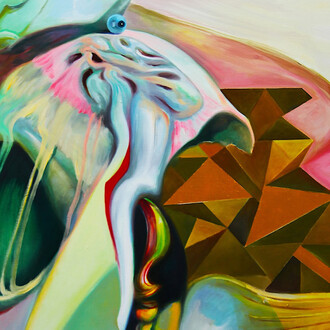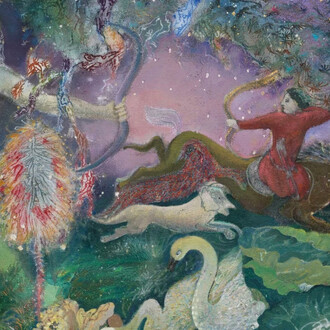David Zwirner is pleased to present an exhibition of works by John McCracken at the gallery's 537 West 20th Street location in New York. Drawn primarily from the last decade of the artist's career, the works on view explore varying articulations of seriality within the artist's diverse oeuvre, and the way in which he engaged formal concerns, such as verticality, surface, and particularly color, as a means of composing simple, but deeply resonant sculptures and installations.
McCracken occupies a singular position within the recent history of American art, as his work melds the restrained formal qualities of Minimalist sculpture with a distinctly West Coast sensibility expressed through color, form, and finish. He developed his early sculptural work while studying painting at the California College of Arts and Crafts in Oakland in the late 1950s and early 1960s. While experimenting with increasingly three-dimensional canvases, the artist began to produce objects made with industrial materials, including plywood, sprayed lacquer, and pigmented resin, creating the highly reflective, smooth surfaces that he was to become known for.
For McCracken, color was an integral element of his practice, writing in 1966, "I think of color as being the structural material I use to build the forms I am interested in…I have found that a certain range of mainly primary and secondary colors and a certain combination of color intensity and transparency and surface finish provide me with the expressive means I want."¹ He considered similar or even identical forms executed in differing hues to be entirely individuated artworks that engage with their surroundings in a distinct way. By grouping such forms—sometimes within larger installations—he was able to explore the effects of repetition and difference, while pursuing properties of "clarity, conciseness, and effectiveness," in his work. As the artist elaborated, "In distilling my ideas I was doing something analogous to making poetry—trying, in a way, to say the most with the least."²
The exhibition will present key examples from three discrete groups of work—leaning multi-part wall pieces, wall-mounted multi-part reliefs, and freestanding columns—that McCracken created outside of his iconic "planks." On view will be a selection of the artist's "Beam" works, each comprising multiple tall narrow components that lean against the wall, first exhibited in his 2008 solo presentation at David Zwirner, but illuminated in his sketchbook as early as the 1970s. Some multi-part works, such as Space (2008), consist of a rhythmic combination of an array colors, here blue and green; while others like Song (2008) explore tonal, more subtle variations within a single color, in this case red; still others like the all-white work Chakra (2008) are monochromatic. Titles are likewise employed as a pictorial metaphor in McCracken's lesser-known wall reliefs, such as Fire (2007), created for documenta 12 in 2007, and Light (2004), which exist in the interstices of painting and sculpture. Finally, a grouping of four eight-foot tall freestanding columns, arranged in a configuration similar to the artist’s 2004 exhibition at the gallery, explores the phenomenological relationship between work, viewer, and architecture through their outsized stature.
Beginning in the 1960s, John McCracken (1934-2011) exhibited steadily in the United States and abroad, and his early work was included in groundbreaking exhibitions such as Primary Structures at the Jewish Museum, New York (1966), and American Sculpture of the Sixties at the Los Angeles County Museum of Art (1967). In 1986, the major survey Heroic Stance: The Sculpture of John McCracken 1965-1986 was organized by P.S.1 Contemporary Art Center, Long Island City, New York, and traveled to the Newport Harbor Art Museum (now the Orange County Museum of Art), Newport Beach, California; Fine Arts Gallery, University of California, Irvine; and the Contemporary Arts Museum Houston, Texas. In 2011, his work was the subject of a large-scale retrospective at Castello di Rivoli, Turin. Other significant solo shows include the Inverleith House, Royal Botanic Garden Edinburgh (2009); Stedelijk Museum voor Actuele Kunst (S.M.A.K.), Ghent (2004); Hochschule für Angewandte Kunst, Vienna; and the Kunsthalle Basel (both 1995).
McCracken’s work has been prominently featured in major group exhibitions worldwide, most recently in three shows organized as part of the 2011 region-wide initiative Pacific Standard Time: Art in L.A. 1945-1980 at the Getty Center, Los Angeles; Museum of Contemporary Art San Diego, La Jolla, California; and Pomona College Museum of Art, Claremont, California. Other group exhibitions include Time & Place: Los Angeles 1957-1968, Moderna Museet, Stockholm (2008); documenta 12, Kassel, Germany (2007); The Los Angeles Art Scene, 1955-1985, Centre Georges Pompidou, Paris (2006); and A Minimal Future? Art as Object 1958-1968, Museum of Contemporary Art, Los Angeles (2004).
Work by the artist is held in prominent international collections, including the Art Gallery of Ontario, Toronto; The Art Institute of Chicago; Castello di Rivoli, Turin; Los Angeles County Museum of Art; Musée d’art contemporain de Montréal; Musée d’art moderne et contemporain (MAMCO), Geneva; Museum of Contemporary Art, Los Angeles; The Museum of Modern Art, New York; Orange County Museum of Art, Newport Harbor, California; Palais des Beaux-Arts, Brussels; San Francisco Museum of Modern Art; Solomon R. Guggenheim Museum, New York; and the Whitney Museum of American Art, New York.
David Zwirner has represented the work of John McCracken since 1997. This is the seventh solo presentation of his work at the gallery.
















